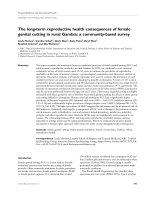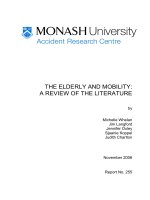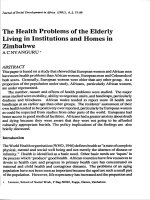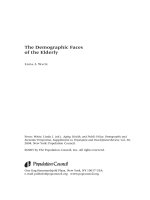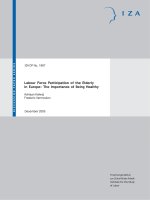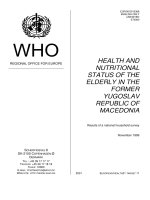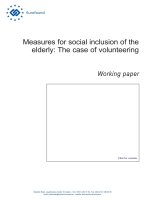Health Council of the Netherlands Undernutrition in the elderly pdf
Bạn đang xem bản rút gọn của tài liệu. Xem và tải ngay bản đầy đủ của tài liệu tại đây (11.01 MB, 112 trang )
Health Council of the Netherlands
Undernutrition in the elderly
Gezondheidsraad
H e a l t h C o u n c i l o f t h e N e t h e r l a n d s
To the Minister of Health, Welfare and Sport
P. O . B o x 1 6 0 5 2 V i s i t i n g A d d r e s s
N L - 2 5 0 0 B B T h e H a g u e P a r n a s s u s p l e i n 5
Te l e p h o n e + 3 1 ( 7 0 ) 3 4 0 5 8 2 2 N L - 2 5 11 V X T h e H a g u e
Te l e f a x + 3 1 ( 7 0 ) 3 4 0 7 5 2 3 T h e N e t h e r l a n d s
E - m a i l : c j k . s p a a i j @ g r . n l w w w . h e a l t h c o u n c i l . n l
Subject : presentation of advisory report Undernutrition in the elderly
Your reference : VGP/VV 2943967
Our reference : I-237/09/CS/cn/854-B
Enclosure(s) : 1
Date : November 29, 2011
Dear Minister,
On 18 August 2009, the Minister of Health, Welfare and Sport at the time asked for advice
from the Health Council concerning energy-protein undernutrition. I would hereby like to
present the advisory report Ondervoeding bij ouderen (Undernutrition in the elderly). I will
also send this to the Minister of Economic Affairs, Agriculture and Innovation today.
In order to advise you, an appointed committee of experts has analysed the results of the
available research. The Standing Committee on Nutrition, the Standing Committee on
Medicine and the Advisory Committee on Health Research have reviewed the findings.
The requests for advice were connected with the memorandum Gezonde voeding, van begin
tot eind (Health Nutrition, from beginning to end), which the Government sent to the House
of Representatives in July 2008. A lot is being done in hospitals, care facilities and in
primary care and home care to recognise and treat undernutrition. The questions posed to
the Health Council were aimed at improving the policy in this field with a scientific
foundation of the diagnostics and treatment of undernutrition.
However, the Committee has concluded that the scientific foundation of this problem is
inadequate. We often do not know whether elderly people are ill and undernourished as a
result, or whether the undernourishment actually contributes to the occurrence or
exacerbation of an illness. The advice has raised more questions than answers. The
uncertainties relate to the manner in which undernutrition can be diagnosed and the benefits
Gezondheidsraad
H e a l t h C o u n c i l o f t h e N e t h e r l a n d s
Subject : presentation of advisory report Undernutrition in
the elderly
Our reference : I-237/09/CS/cn/854-B
Page : 1
Date : November 29, 2011
P. O . B o x 1 6 0 5 2 V i s i t i n g A d d r e s s
N L - 2 5 0 0 B B T h e H a g u e P a r n a s s u s p l e i n 5
Te l e p h o n e + 3 1 ( 7 0 ) 3 4 0 5 8 2 2 N L - 2 5 11 V X T h e H a g u e
Te l e f a x + 3 1 ( 7 0 ) 3 4 0 7 5 2 3 T h e N e t h e r l a n d s
E - m a i l : c j k . s p a a i j @ g r . n l w w w . h e a l t h c o u n c i l . n l
gained by treating undernutrition. As undernutrition is a potentially serious problem, I think
that it is essential to provide a powerful impulse in this field of nutritional research. That
research should focus on determining the efficacy of supplementation. This advisory report
provides a guide in this.
Yours sincerely,
(signed)
Prof. D. Kromhout,
Vice President
Undernutrition in the elderly
to:
the Minister of Health, Welfare and Sport
No. 2011/32E, The Hague, November 29, 2011
The Health Council of the Netherlands, established in 1902, is an independent
scientific advisory body. Its remit is “to advise the government and Parliament on
the current level of knowledge with respect to public health issues and health
(services) research ” (Section 22, Health Act).
The Health Council receives most requests for advice from the Ministers of
Health, Welfare & Sport, Infrastructure & the Environment, Social Affairs &
Employment, Economic Affairs, Agriculture & Innovation, and Education,
Culture & Science. The Council can publish advisory reports on its own
initiative. It usually does this in order to ask attention for developments or trends
that are thought to be relevant to government policy.
Most Health Council reports are prepared by multidisciplinary committees of
Dutch or, sometimes, foreign experts, appointed in a personal capacity. The
reports are available to the public.
This report can be downloaded from www.healthcouncil.nl.
Preferred citation:
Health Council of the Netherlands. Undernutrition in the elderly. The Hague:
Health Council of the Netherlands, 2011; publication no. 2011/32E.
all rights reserved
ISBN: 978-90-5549-898-7
The Health Council of the Netherlands is a member of the European
Science Advisory Network for Health (EuSANH), a network of science
advisory bodies in Europe.
INA HTA
The Health Council of the Netherlands is a member of the International Network
of Agencies for Health Technology Assessment (INAHTA), an international
collaboration of organisations engaged with health technology assessment.
Contents 9
Contents
Executive summary 13
Part 1 Advisory report Undernutrition in the elderly
1 Introduction 15
2 Prevalence of undernutrition in the elderly 19
3 Methods of screening for undernutrition 25
4 Effectiveness of treatment with extra protein and energy 27
5 Conclusions and recommendations 31
Literature 35
Annexes 39
A Request for advice 41
B The Committee 43
10 Undernutrition in the elderly
Part 2 Background document Undernutrition in the elderly
A1 Prevalence of undernutrition 47
A1.1 The data sets on which the prevalence data are based: LPZ and LASA 47
A1.2 Prevalence of undernutrition in the elderly 50
A1.3 Scientific justification for the criteria 52
A1.4 Summary and consideration 62
A1.5 Conclusion 63
A2 Evaluation of screening instruments 65
A2.1 Evaluation of five instruments 65
A2.2 Subjective Global Assessment (SGA) 68
A2.3 Mini Nutritional Assessment (MNA) 72
A2.4 Short Nutritional Assessment Questionnaires (SNAQ, SNAQRC and SNAQ65+) 76
A2.5 Nutritional risk screening 2002 (NRS-2002) 80
A2.6 Malnutrition Universal Screening Tool (MUST) 83
A2.7 Summary and consideration 85
A2.8 Conclusion 88
A3 Effectiveness of treatment with extra protein and energy 89
A3.1 The Committee’s approach 89
A3.2 The meta-analysis of Milne et al from 2009 92
A3.3 RCTs of relatively better quality in the undernourished elderly 97
A3.4 Summary and consideration 103
A3.5 Conclusion 103
Literature 105
Undernutrition in the elderly
11
1 Introduction
2 Prevalence of undernutrition
3 Methods of screening for undernutrition
4 Effectiveness of treatment with extra protein and energy
5 Conclusions and recommendations
Part 1
12
Executive summary 13
Executive summary
In recent years, there has been an increasing focus on the issue of undernutrition
in the elderly. Hospitals and care institutions are alert to the risk of protein and
energy deficiency in the elderly and provide nutritional supplementation where
this is deemed to be necessary. This is considered to be a necessary step to
improve the health of elderly people. The Minister of Health, Welfare and Sport
has asked the Health Council of the Netherlands to provide a scientific basis for
the way undernutrition is dealt with. What is the exact scope of the problem,
what is the best way of identifying cases of undernutrition, and how can this
condition best be treated? The Health Council has now collated the available data
on this issue.
Over the long term, inadequate protein and energy intake is known to be harmful
to health. However, it is not clear exactly where the boundary lies. When can
someone be said to be undernourished? In practice, a range of methods is used to
measure undernutrition (such as recent weight loss, and a low Body Mass Index).
There is no “gold standard” (i.e. a reliable method). While various studies have
demonstrated the existence of a link between undernutrition and mortality rate,
for example, it is not known whether a causal connection exists. In other words,
are elderly people at greater risk of dying as a result of undernutrition, or is their
higher mortality risk mainly due to other factors, such as disease? As long as
there is no clarity on this issue, there will be no reliable data on the severity and
scope of the problem of undernutrition in the elderly.
14 Undernutrition in the elderly
Furthermore, many questions still remain to be answered concerning the
effectiveness of dietary interventions in the elderly. While a great deal of
research has been published in this area, the quality of the research in question is
substandard. According to the Health Council, nutritional supplementation with
extra protein and energy should produce clear health gains, such as shorter
hospital stays or a lower mortality risk. However, it is impossible to identify
those cases to which this would apply.
The current approach to undernutrition in the elderly is based on the view that the
treatment of this condition is always worthwhile. However, this view is very
much open to debate. Given the lack of a reliable method of measurement, too
many elderly people may be classified as being undernourished. Accordingly, for
some of these individuals, nutritional supplementation with extra protein and
energy may not actually help to improve their health. Part of the elderly people
who have experienced weight loss due to illness may also recover by receiving
proper medical treatment, without a contributing effect of nutritional
supplementation. There is another category of undernourished elderly people,
however, for whom nutritional supplementation is essential to their health. As
yet, there are no exact details concerning the cases to which this would apply. A
better understanding of this issue is needed if undernutrition is to be dealt with
effectively.
Undernutrition can be harmful to health, so it is vital to ensure that elderly people
enjoy a good nutritional status. However, solid scientific research is needed to
identify the magnitude of the problem, and the most effective way of dealing
with it. According to the Health Council, collaboration between care providers is
needed to achieve studies of good quality and sufficient scope.
Introduction 15
1
Chapter
Introduction
Request for advisory report
There is much attention in society to protein-energy undernutrition in hospitals,
care institutions and in home care. It appears from investigations and signals that
a quarter of clients in health care are undernourished and that elderly people and
the chronically ill form an important risk group. Hospitals, care institutions and
home care therefore do a great deal to recognise and treat protein-energy
undernutrition early. In 2005, the Steering Group ‘Wie beter eet wordt sneller
beter’ (‘Whoever eats better gets better quicker’), otherwise known as the
Malnutrition Steering Group, was formed, which focuses on optimal care
concerning prevention, detection and treatment of undernutrition.
1
A National
Primary health care Collaboration Covenant (in Dutch, LESA) was published in
2010 for the purposes of primary health care in the field of undernutrition; this
contained agreements about screening for (district) nursing care, diagnosis,
referral by the GP, treatment by the dietician, and the times when consultation is
necessary.
2
Sections were targeted at combating undernutrition in the elderly in
two – now completed – ZonMw (Netherlands Organisation for Health Research
and Development) programmes: the project ‘Sneller Beter’ (‘Better Quicker’)
was directed at elderly people in hospitals and the improvement track ‘Eating
and drinking’ in the programme ‘Zorg voor Beter’ (‘Take Better Care’) at the
non-independently-living elderly. In all these activities, the emphasis was and is
on a purposeful approach in practice.
16 Undernutrition in the elderly
In the data from 2008 about nutrition and health, ‘Gezonde Voeding, van begin
tot eind’ (‘Healthy Nutrition, from start to finish’), the Government put the
problem of undernutrition in care on the agenda. From the wish to reinforce the
approach to this problem with a scientific justification of the diagnosis and
treatment, the Minister asked the Health Council for an advisory report. This
concerns a scientific opinion on:
• the extent and impact of the problem of protein-energy undernutrition
• the methods of screening for protein-energy undernutrition
• the possible intervention points for reducing undernutrition and the
percentage of the current prevalence of undernutrition that is avoidable
• the gain that is directly or indirectly possible through treatment of people
with protein-energy undernutrition, for the perception of clients, for care
provision as well as from a financial viewpoint.
The Minister has requested the Health Council, in responding to the request for
advice, to take account of the different parts of the care chain and the various
care professionals who are involved with (the solution of) the problem. The
complete advisory report request may be found in Annex A.
To prepare the said report, the Council set up a Committee. The composition of
the Committee is given in Annex B. The advisory report was evaluated in the
Standing Committee on Nutrition, and in the Advisory Committee on Health
Research.
Delineation
Based on the advice questions, this advisory report is specifically targeted at
undernutrition as a result of inadequate intake of protein and energy (referred to
hereafter as ‘undernutrition’). Shortages of vitamins and minerals can also have
undesirable consequences for health, but fall outside the scope of this report.
*
The Committee opts for a demarcation to undernutrition in the elderly (over
65 years old). The prevalence in care institutions would appear to increase
gradually with age from 65 years, while prevalence figures in younger patients
are more or less stable.
3
The causes of the higher prevalence of undernutrition in
the elderly are various. As elderly people of increasing age become less
* In the research available, deficiencies of micronutrients may well be present; a proportion of the
people with protein-energy undernutrition also in fact have deficiencies of certain vitamins or
minerals.
Introduction 17
physically active, their energy demand decreases, and so generally does their
energy intake. The energy intake can also reduce due to a reduction in appetite.
This may be caused in the elderly by a reduced appreciation of food as a result of
changes in the perception of tastes and smells, by psychosocial factors like
loneliness, grief and depression, or by illness or infections. There are therefore
many reasons why elderly people start to eat less. In order nevertheless to fulfil
the need for protein, vitamins and minerals while eating and drinking less,
qualitatively higher grade nutrition is required.
In the evaluation of the clinical utility of nutritional intervention, the
Committee directs itself towards clinically relevant effects of the provision of
extra protein and energy via foodstuffs, liquid foods or supplements. These
interventions link up best with the increased broad approach to protein and
energy undernutrition in care. Foods and supplements that are employed for
serious or more specific problems are excluded from consideration; examples
here are nutrition given via a tube or infusion, and supplementation with vitamins
or minerals or with substances that can affect the immune system.
Lack of clarity on definition and assessment of undernutrition
There is no consensus either nationally or internationally about what
undernutrition is exactly, or how it can be established. The consequence is that
the concept of undernutrition is put into practice in different ways in the
available research. The Committee describes from the available research not only
the results but also the way in which undernutrition is established and discusses
where necessary the implications of the diversity of definitions employed.
Structure of the advisory report
The Committee has made an inventory of the data available about undernutrition
in the elderly and then assessed the scientific justification of this. Although a
large number of studies into undernutrition have been published, only a small
part of them are qualitatively good enough to serve as basis for this advisory
report. The Committee does discuss all this research, but has opted for the sake
of readability to present the methodological evaluation of the studies in a
Background document. This advisory report therefore comprises two parts: a
main text with the results of the analyses, the line of argument and a reaction to
the advice questions, and a Background document in which the complete data are
discussed. In the advisory report, the Committee refers to the relevant passages
in the Background document.
18 Undernutrition in the elderly
In Chapter 2, the Committee discusses figures about undernutrition in elderly
Dutch people and evaluates the scientific basis of the criteria with which
undernutrition is established. Then, in Chapter 3, the instruments for screening
come into consideration, including the data on the quality of these instruments.
Chapter 4 considers the effectiveness of treatment with nutritional supplements.
It contains an analysis of the research that has been published on this and an
evaluation of its results. In Chapter 5, the Committee formulates its conclusions
and recommendations.
Prevalence of undernutrition in the elderly 19
2
Chapter
Prevalence of undernutrition in the
elderly
There is no consensus either nationally or internationally about the definition of
undernutrition. Studies that have been published on the subject each define in
their own way what undernutrition is. The definition chosen of course affects the
results of the study. This is also the case in the Dutch investigations into the
prevalence of undernutrition.
Dutch figures
In the Netherlands, the prevalence of undernutrition has been determined
annually since 2004 in the National Prevalence Survey on Health Care Problems
(LPZ).
4
Because this contains little information specifically on the elderly, the
LPZ also carried out additional analyses on the Health Council’s request.
*
The
LPZ provides data about undernutrition in hospitals, nursing and care homes, and
home care. The prevalence of undernutrition in the Dutch elderly living
independently at home is determined in the Longitudinal Aging Study
Amsterdam (LASA
**
).
5
These data are also considered.
* For these analyses, the data about the elderly from the LPZ surveys of 2008, 2009 and 2010 were
combined. The analyses were carried out by Dr. J.M.M. Meijers in consultation with Committee
member Prof. J.M.G.A. Schols and the project leader of the LPZ, Dr. R.J.G. Halfens (MUMC
Maastricht).
** These LASA data were collected in the years 2005 and 2006.
20 Undernutrition in the elderly
In the LPZ study, undernutrition in the elderly is established on the basis of three
criteria: a body mass index (BMI) of less than 20.0 kg/m
2
, recent unintentional
weight loss or recent reduction in food consumption.
4
The criterion for
unintentional weight loss is a reduction of at least 3 kilos in the last month or 6
kilos in the last 6 months. If a person has not eaten or has only eaten little for
three days, or has eaten less than normal for a week, then there is considered to
be a reduction in food consumption. Within the LPZ, reduced food consumption
is only considered to be a criterion for undernutrition if the elderly person
concerned has a BMI between 20.1 and 23.0 kg/m
2
.
In the LASA study, undernutrition is established based on two criteria: a BMI
less than 20.0 or an unintentional weight loss of at least 5 per cent in the last six
months.
5
Table 1 gives an overview of the prevalence estimates. To gain insight into the
effect of the differences in the criteria on the prevalence data, both definitions are
applied to the LPZ data. The LASA result for the independently-living elderly
without home care is set out alongside. The table clearly shows that the
difference in the criteria used to establish undernutrition leads to seriously
divergent prevalence estimates. The largest difference occurred for the two
figures on undernutrition in hospitals: depending on the criteria, these were 18 or
33 per cent. The differences in the other care settings were smaller. In nursing
and care homes, around 20 per cent of the elderly were considered to be
Table 1 Prevalence of the separate criteria for undernutrition.
a
a
The sum of the prevalences of the separate criteria is higher than the prevalence of undernutrition, because a proportion of
the elderly people meets multiple criteria.
Nature of data Prevalentieschattingen
Data set Criteria
employed
b
b
A description of the
criteria used in the LPZ and in the LASA study may be found on the previous page.
Hospitals Nursing and care
homes
Home care Independent
without home
care
Undernutrition LPZ LPZ 33% 21% 16%
LPZ LASA 18% 18% 12%
LASA LASA 7%
A low BMI LPZ LPZ 11% 15% 8%
LPZ LASA 10% 15% 8%
LASA LASA 3%
Unintentional weight
loss
LPZ LPZ 24% 9% 10%
LPZ LASA 12% 5% 5%
LASA LASA 5%
Reduced intake with
BMI 21-23
LPZ LPZ 7% 2% 2%
Prevalence of undernutrition in the elderly 21
undernourished. For the elderly people living independently without home care
this was around 7 per cent. Because the great majority of the Dutch elderly (94
per cent in 2003) lives independently, this setting supplies the greatest proportion
in an absolute sense of the total number of Dutch elderly considered to be
undernourished.
In those elderly people living independently and in hospitals considered to be
undernourished, the main issue was unintentional weight loss; this was the case
in around 70 per cent of these undernourished elderly people. In nursing and care
homes, that percentage was substantially lower (30-40 per cent), but 70 to 80 per
cent of the elderly people considered as undernourished had a low BMI. The
prevalence data are described in detail in Sections A1.1 and A1.2 of the
Background document.
Justification of criteria to establish undernutrition: the relationship
with a negative prognosis
In order to establish the extent and impact of the problem of undernutrition, a
dependable definition is vital. For this reason, the Committee put the scientific
justification of the factors that often play a role in establishing undernutrition
under the microscope: a low BMI, unintentional weight loss and reduced food
consumption. Are these factors associated with a negative prognosis, and if so, is
it possible to make pronouncements about causality? In the scientific literature,
the justification of these characteristics of undernutrition is based on the
associations with the mortality risk. The Committee observes that other outcome
measures may also be relevant, but that the scientific knowledge about
associations of characteristics of undernutrition with outcome measures other
than mortality is extremely limited.
Research reveals that a low BMI is associated with increased mortality.
Recently, two large meta-analyses on this subject were published in prominent
journals.
6,7
Smoking habits play an important role in the association between a
low BMI and an increased mortality risk. According to some publications, there
are indications that the BMI range within which the mortality risk is lowest lies
at a higher BMI level in the elderly that in young adults
6,8-10
, but this is not
consistently found in all publications.
7
The shift could be partly due to the
reduction in stature with time. According to the Committee, the available
research is not sufficient in order to specify a limit value for the elderly, below
which the BMI is considered too low (in relation to increased mortality). It is
equally impossible to make out from the data whether a life-long stable but low
22 Undernutrition in the elderly
BMI increases the mortality risk. There is more information on this in the
Background document: A1.3.1.
Weight loss is also associated with an increased mortality risk. Two studies
provide indications that this mainly applies when the weight loss is
unintentional.
11,12
In one study in which the association with mobility restrictions
was investigated, associations were reported for subgroups with unintentional or
intentional weight loss.
13
Six other studies make no distinction between
unintentional and intentional weight loss.
14-19
It was found in two studies that the
association between weight loss and mortality does not only exist at a low BMI,
but also at a normal or high BMI.
13,17
The research is described in the
Background document: A1.3.2.
Insufficient justification exists for reduced food consumption as an indicator
of undernutrition: it was found in one study that reduced food consumption is
associated with an increased mortality risk in the short term.
20
In that study, it
was not investigated whether the said association is dependent on the BMI (see
Background document A1.3.3).
The relationship among the three factors listed and mortality was investigated in
observational research and therefore concerns associations. An association does
not in fact provide any evidence that these characteristics of undernutrition
increase the risk of death. Illness is potentially an important interfering variable
in the connection between undernutrition and prognosis. Illness may be the cause
of a low BMI, unintentional weight loss and reduced food consumption on the
one hand, and on the other of a poor prognosis. In this way, in observational
research, illness can lead to an association between these characteristics of
undernutrition and a poor prognosis, even if the poor prognosis is the
consequence of illness and not of the said characteristics of undernutrition.
Conclusion
A low BMI, weight loss and reduced food consumption are associated with a
higher mortality risk. Due to the absence of trials, it is unclear whether causality
exists in these associations. The cut-off points are equally poorly scientifically
justified. For this reason, the meaning of these characteristics for establishing
undernutrition is uncertain. In order to achieve certainty, research into the
causality of the relationship between the characteristics of undernutrition and the
prognosis is necessary. Questions that remain open include:
• Is someone with a life-long stable yet low BMI actually undernourished? If
undernutrition arises through a gradual reduction in body weight over a
Prevalence of undernutrition in the elderly 23
period of years, is a low BMI then the best indicator or would it be better to
assess the weight loss over longer periods? Do nutritional interventions
through which a low BMI is corrected to a target value lead to a better
prognosis?
• Weight loss and reduced food consumption often occur in ill people and in
people with psychosocial problems like loneliness, grief and depression. Is
the association of these characteristics with a poor prognosis caused by the
characteristics of undernutrition (the weight loss or the reduced
consumption) or by the underlying illnesses or problems? Are elderly people
better off when the weight loss or reduced consumption is combated or
corrected via nutritional intervention?
According to the available research data, undernutrition in the elderly would
appear to be a substantial problem, but the state of science is inadequate to assess
the value of these prevalence data. Only when clarity is achieved about the
questions of causality and there is a golden standard for establishing
undernutrition can certainty be gained about the extent and seriousness of the
problem.
24 Undernutrition in the elderly
Methods of screening for undernutrition 25
3
Chapter
Methods of screening for
undernutrition
On the Minister’s request, the Committee presents a scientific opinion about the
instruments for identifying undernutrition.
Instruments
Five instruments are the most relevant for the Netherlands:
• the Subjective Global Assessment (SGA)
• the Mini Nutritional Assessment (MNA)
• the Short Nutritional Assessment Questionnaires for hospitals (SNAQ),
nursing and care homes (SNAQ
RC
) and the elderly in first-line and home care
(SNAQ
65+
)
• the Malnutrition Universal Screening Tool (MUST) and
• the Nutrition Risk Screening 2002 (NRS-2002).
The instruments are presented, described and discussed in the Background
document: A2.2 to A2.6. They take the form of a questionnaire, sometimes
supplemented with some measurement values. The three characteristics of
undernutrition sketched out above – weight loss, a low BMI and reduced food
consumption – often play a major role. Besides these, the more complex
instruments are based on information about factors such as illnesses that increase
the probability that weight loss, a low BMI and reduced food consumption will
occur.
